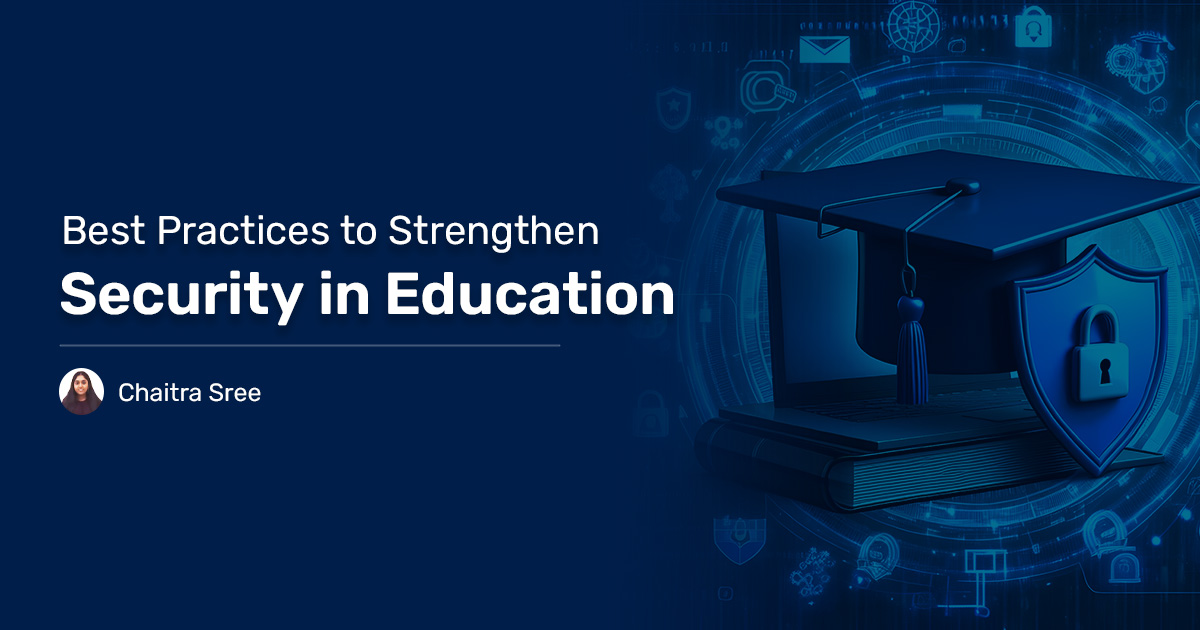In today’s digital age, education has embraced technology like never before. While this transformation has brought countless benefits, it has also exposed educational institutions to cybersecurity threats.
“87% of Educational Establishments Have Suffered Successful Cyberattacks,”- according to stats. Additionally, the educational sector is ranked 6 among the?other 20 sectors!
Understanding these threats and implementing effective protective measures is vital to safeguarding sensitive data and ensuring a safe learning environment.
In this blog, let’s explore the importance of cybersecurity in education, why is it the prime target and some best practices to keep institutions safeguarded.
Importance of Cybersecurity in Education
Cybersecurity in education is not merely a technical requirement; it’s a fundamental component of fostering a safe and secure environment for students and teaching staff.
With an increasing reliance on digital tools for everything from classroom instruction to administrative tasks, the importance of protecting sensitive information—such as student records, financial data, and personal identification—cannot be overstated.
Especially during the COVID era, where the teaching unit was completely shifted to remote environment. A single breach would have led to identity theft, financial loss, and damage to an institution’s reputation.
To address this issue, it’s essential to understand the common types of attacks the educational sector usually faces.
Common Cybersecurity Threats in the Education Sector
Educational institutions face a variety of cybersecurity threats, including:
- Phishing Attacks: Cyber attackers often use suspicious emails to trick students and staff into revealing personal information. It can also be in the form of “Back to school” sales or even sending out a fake staff instruction.
- Ransomware: This malicious software can encrypt critical data, rendering it inaccessible until a ransom demanded is paid.
- Data Breaches: Unauthorized access to sensitive data can occur through inadequate security measures, often resulting in the loss of personal and financial information.
- DDoS Attacks: Distributed Denial of Service (DDOS) attacks can overwhelm institutional servers, causing significant disruptions to online learning and administrative functions.
- Unsecured Networks: Its of high chance that students and even staff use public Wi-Fi networks for their purposes this will leave a loophole for attackers to exploit potential cyber threats.
Why Education is the Prime Target
Educational institutions are particularly attractive targets for cyber attackers for several reasons:
- Valuable Data: Schools and universities contain vast amounts of personal and financial information about students, faculty, and staff, making them potential targets.
- Limited Resources: Many educational institutions operate with tight budgets and may not have the resources to implement robust cybersecurity measures.
- Wide Accessibility: Educational environments’ open nature can make it easier for attackers to access systems and networks.
- Lack of Awareness: Many individuals in educational settings may not receive adequate training to recognize or respond to cybersecurity threats.
Best Practices to Keep Your Education Enterprise Safe
To remediate these risks, educational institutions should adopt best practices, including:
- Regular Training: Conduct ongoing cybersecurity training for staff and students to help them recognize potential threats.
- Strong Password Policies: Implement and enforce policies requiring strong, unique passwords and regular updates. Make sure all the applications you use have two-factor authentication enabled.
- Data Encryption: Use encryption to protect sensitive information or to have sensitive conversations, both in transit and at rest.
- Regular Software Updates: Ensure that all software and systems are up to date with the latest security patches.
- Incident Response Plan: Develop a comprehensive incident response plan to address potential breaches quickly and effectively.
- Access Controls: Limit access to sensitive data and systems based on roles and responsibilities.
To achieve all these best practices, you would need to implement a vulnerability management tool.
How Does SanerNow Protect Educational Enterprises?
SanerNow’s Continuous vulnerability and exposure management (CVEM) solution, specifically designed for the educational sector, addresses the unique challenges and keeps you a step ahead of cyberattacks. Here’s how it can help:
- SanerNow provides comprehensive visibility into all the devices on the network, allowing you to identify risks and ensure nothing is left behind.
- It runs continuous and automated vulnerability scans which just takes 5min and identifies vulnerabilities beyond CVEs such as misconfigurations, posture anomalies, exposures.
- Having an integrated patch management is an added benefit. With SanerNow patch management, you can instantly fix all detected risks as soon as they arise, and promptly apply patches for third-party applications as soon as they become available.
- SanerNow helps educational institutions meet compliance requirements related to data protection and cybersecurity.
- It also provides a reporting capabilities, you can always utilize the canned reports generated by SanerNow and reiterate through all strategy or even customize it based on your requirements.
Conclusion
As the education sector continues to evolve digitally, prioritizing cybersecurity is essential. By understanding the common threats and implementing best practices, educational institutions can better protect themselves from potential cyberattacks. Solutions like SanerNow provide the necessary tools and support to create a secure environment for learning, ensuring that educational institutions can focus on what they do best—educating the next generation.


